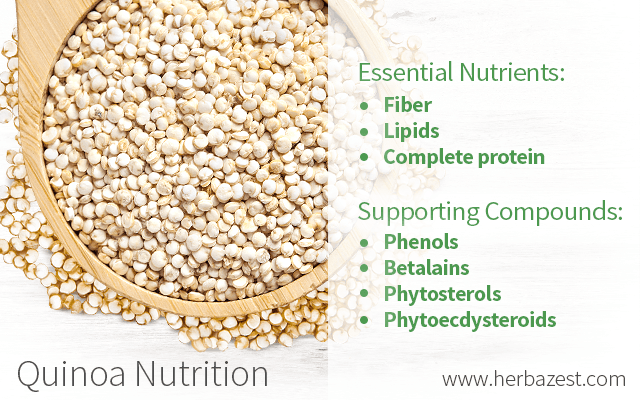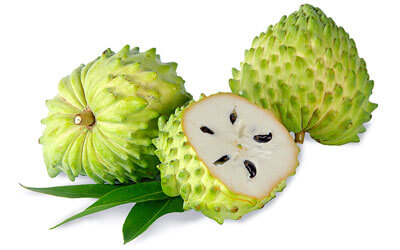Quinoa has been cultivated in the Andean region of South America for over 7,000 years, but its rich nutritional profile hasn't been recognized or celebrated by the rest of the world until recently.1 Originally slighted by Europeans as peasant food during the time of the Spanish conquest, quinoa's nutrients - including essential amino acids, vitamins, and minerals - have been proven a necessary requirement for sustained human health.
Essential Nutrients in Quinoa
Quinoa has a very interesting nutritional profile. Some of the most prominent quinoa's nutrients include amino acids - which are the building blocks of protein - as well as fiber and lipids.
Most of the nutritional benefits of quinoa are due to the fact that the pseudograin boasts all nine essential amino acids, making it a complete protein source.
ONE CUP OF COOKED QUINOA OFFERS 8 GRAMS OF PROTEIN.1
Quinoa's nutritional benefits are comparable to other well-known protein sources. Quinoa contains about as much protein as milk, but more protein than wheat, rice, or maize, making it one of the best vegetable protein sources available. The high-quality protein content in quinoa makes it an excellent source of nutrition for infants, children, and people following vegetarian and vegan diets.
Furthermore, quinoa is an excellent source of dietary fiber. The consumption of fiber-rich diets has been associated with a lower risk of developing type 2 diabetes and cardiovascular disease. Nutritional value aside, quinoa's fiber content makes up 3 - 10% of its weight.
Lipids are another important nutrient in quinoa. As concentrated sources of energy, lipids are necessary to help the body perform many normal functions. However, while lipids can be accessed through many foods, their quality and type is very important. The most abundant lipids in quinoa are unsaturated fatty acids, which have been associated with reduced inflammation and other health benefits.
Supporting Compounds in Quinoa
Besides quinoa's rich nutrient profile, it is also a good source of the following supporting compounds:
- Phenols. Polyphenol compounds are important as they have been shown to have antioxidant, anti-allergen, anti-inflammatory, and antiviral effects.
- Betalains. These compounds give the seeds and vegetation of quinoa their varied yellow, red, and black colors. The most abundant betalain compounds in quinoa are betanin and isobetanin, which have healthful properties similar to phenolic compounds. However, these compounds exhibit more potent antioxidant activity.
- Phytosterols. Very similar in structure to cholesterol, phytosterols have significant hypocholesterolemic effects since they compete with cholesterol when the intestines attempt to absorb cholesterol. In addition, they have anti-inflammatory and antioxidant effects. While the phytosterol content of quinoa has received very little attention, quinoa seeds contain levels of phytosterol up to 118 milligrams per 100 grams.
- Phytoecdysteroids. Of all edible agricultural crops, quinoa contains the highest levels of phytoecdysteroids, which have been linked to many important biological activities. They are thought to have growth-promoting, immunomodulatory, neuroprotective, hypocholesterolemic, antidepressive, wound-healing, antioxidant, hepatoprotective, and antidiabetic effects.
Quinoa's Nutrition Facts
These are some interesting quinoa nutrition facts:
- Quinoa contains saponins, which are naturally occurring compounds considered to play an important role against pathogens, pests, and herbivores. Saponins have a bitter taste, so it is best to remove them by washing the seeds before consumption.
- Some minerals present in quinoa are calcium, magnesium, and potassium. These minerals are essential for regulating electrolytes, glucose, and the transmission of nerve impulses in the body.
- Quinoa is a rich source of micronutrients, including vitamins B9, B6, and E as well as iron.
- Quinoa seeds contain all nine essential amino acids, with particularly high levels of lysine, which is required by the body for optimum growth.
- Quinoa is gluten-free, making it an important dietary component for people who suffer from gluten intolerance and celiac disease.
Based on quinoa's nutritional information, it can be concluded that this Andean seed is a powerhouse of health benefits. It is worth incorporating quinoa recipes as part of a healthy diet.
Sources
- Comprehensive Reviews in Food Science and Food Safety, , Innovations in Health Value and Functional Food Development of Quinoa (Chenopodium quinoa Willd.), 2015
- Food Reviews International, Nutritional Value and Use of the Andean Crops Quinoa (Chenopodium quinoa) and Kañiwa (Chenopodium pallidicaule), 2003
- Journal of Nutrition and Food Sciences, Quinoa (Chenopodium quinoa Willd), from Nutritional Value to Potential Health Benefits: An Integrative Review, 2016
- FAOSTAT, State of the Art Report on Quinoa Around the World in 2013, Chapter 3.5: Nutraceutical Perspectives of Quinoa, Biological Properties and Functional Applications
- USDA Nutrient Database, Quinoa, uncooked
Footnotes:
- Frontiers in Plant Science. (2016). The Global Expansion of Quinoa: Trends and Limits. Retrieved September 28, 2022 from https://www.frontiersin.org/articles/10.3389/fpls.2016.00622/full
- Harvard T.H Chan. (n.d.). Quinoa. Retrieved September 20, 2021 from https://www.hsph.harvard.edu/nutritionsource/food-features/quinoa/




